|
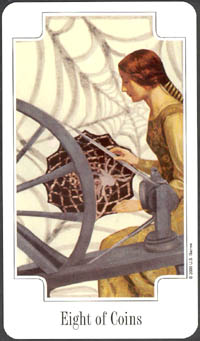 Ten years have passed since Arnell Ando's Transformational Tarot first came into being as a self-published
deck. Ten years it took to get it into print with one of the two major tarot mass-media publishers. Now it
is here, at last.
Ten years have passed since Arnell Ando's Transformational Tarot first came into being as a self-published
deck. Ten years it took to get it into print with one of the two major tarot mass-media publishers. Now it
is here, at last.
Ten years ago, tarot decks based upon collage technique were not as common as they are today. There were a
few though; I can mention Wanless/Knutzon's Voyager Tarot, a commercial and heavily promoted pack created
with the sole purpose of being a foundation for a large scale tarot-business. Another early collage deck
was "The Goose is Out" published in a rather limited edition back in 1982 in Italy for the Rajneesh
Foundation and mainly distributed within the Rajnesh/Osho organization.
The current collage tarot trend started with the self-publication of Arnell Ando's Transformational Tarot
in 1995. Arnell had returned to the USA after several years in Japan, and in search of a career she studied
to become a Jungian based Certified Expressive Art Therapist. She soon discovered the possibilities that
collage techniques offered people, who were not versed in traditional artistic ways of expression, to work
artistically. During the period of re-adapting to the American lifestyle, she created for herself her very
first tarot deck, "Hero's Journey" as a means to come in touch with her inner being at a difficult time.
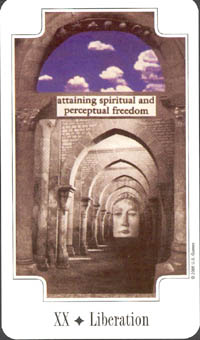 In the early and mid-1990's, personal computers and Photoshop programs were not common and working with
collages meant to collect heaps of source material and select a bit here and a bit there to put it all
together in meaningful, expressive and harmonic ways. Imagine 78 miniature collages made that way and with
a contents more or less corresponding to the traditional tarot! The idea of having her deck published and
made available to a wider circle came up, of course, but had certain limitations. The way lawyers in the US
protect copyrights was scary; even a tiny bit cut from a copyrighted image could cause trouble. Another
obstacle was, perhaps, that the "Hero's Journey" essentially was created for personal reasons and not with
publication in mind, including also elements, which tarotists in general could no relate to. What to do
then? Make another set of 78 meaningful, expressive and harmonic miniature collages, with these limitations
in mind and then invest in the rather risky affair of having the deck printed at her own cost. Thus the
first edition of "Transformational Tarot" came into being.
In the early and mid-1990's, personal computers and Photoshop programs were not common and working with
collages meant to collect heaps of source material and select a bit here and a bit there to put it all
together in meaningful, expressive and harmonic ways. Imagine 78 miniature collages made that way and with
a contents more or less corresponding to the traditional tarot! The idea of having her deck published and
made available to a wider circle came up, of course, but had certain limitations. The way lawyers in the US
protect copyrights was scary; even a tiny bit cut from a copyrighted image could cause trouble. Another
obstacle was, perhaps, that the "Hero's Journey" essentially was created for personal reasons and not with
publication in mind, including also elements, which tarotists in general could no relate to. What to do
then? Make another set of 78 meaningful, expressive and harmonic miniature collages, with these limitations
in mind and then invest in the rather risky affair of having the deck printed at her own cost. Thus the
first edition of "Transformational Tarot" came into being.
Arnell Ando shared the experience she gained from creating the two decks with students at her workshops.
This was the beginning of a new trend: tarot decks, handmade in limited editions, became soon a visible part
of the US-tarot scene. New techniques and reproduction possibilities, such as the use of digital color
copiers and Photoshop, made it easier to publish small print runs in an excellent quality, sometimes an even
better quality than if a traditional printing procedure was used.
Back in 1998, I wrote in an article about such limited edition decks: "....The process is extremely time
consuming and the material used rather costly. So don't expect to be able to buy a 78 card deck made in
10-20 copies for the same $35.-$50. a mass product, printed in thousands, costs. You have to pay about
four times that much, but then you own a tarot deck, that has been particularly cared for by the artist
herself, and there are not thousands of them out there. Worth to pay for, isn't it? And even if the miracle
should happen, that one of them later on was commercially manufactured, that one limited original will
still be a treasure....."
Well, this time the miracle did happen, and, luckily it happened to Arnell Ando's "Transformational Tarot",
which I see as a milestone in the history of modern tarot, a forerunner and inspiration for the dozens of
collage decks published later. It is a well-known fact, that when mass-media publishers take over a tarot
deck, which has been published before, the result can be disastrous; a classic example is the Yeager
Tarot. So it was with some degree of anxiety, I opened up Arnell's deck, when it arrived on my desk a few
days after publication. I had not needed to be that anxious; it did for the most part survive the transition
and a few cards were even improved.
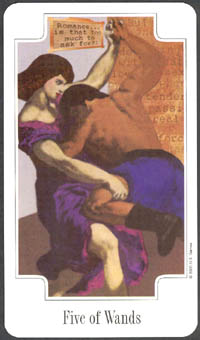 What is the difference actually? In US Games Systems' edition, the cards are slightly larger, definitely an
advantage. The all-over color has a warmer, more red-yellow tinge, which IMO is not an improvement,
separating itself, as it does, from the nature-like colors in the majority of the cards in the first
edition. Particularly the green shades have suffered, being faded and skin tones have become less natural
(just look at the Ace of Cups, if you happen to own both editions). I wonder if the publisher really had
problems rendering the correct tones or if it a conscious change to appeal to customers, who may perhaps
prefer this, since the same color setting is seen in other decks also? In some cards, there is a loss of
sharpness, in others an improvement. Ten of Cups, for example, is an improvement, Three of Swords the
opposite.
What is the difference actually? In US Games Systems' edition, the cards are slightly larger, definitely an
advantage. The all-over color has a warmer, more red-yellow tinge, which IMO is not an improvement,
separating itself, as it does, from the nature-like colors in the majority of the cards in the first
edition. Particularly the green shades have suffered, being faded and skin tones have become less natural
(just look at the Ace of Cups, if you happen to own both editions). I wonder if the publisher really had
problems rendering the correct tones or if it a conscious change to appeal to customers, who may perhaps
prefer this, since the same color setting is seen in other decks also? In some cards, there is a loss of
sharpness, in others an improvement. Ten of Cups, for example, is an improvement, Three of Swords the
opposite.
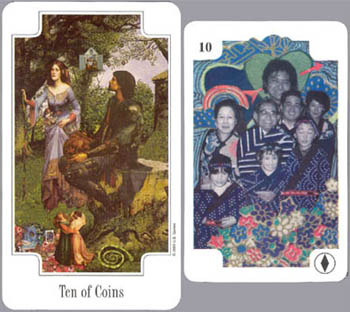 That the deck has been through a Photoshop-treatment along the way, is obvious - what did publishers do before
Photoshop was introduced? - with improvements partly made by the artist herself and partly, I assume, by
US Games Systems' art directors. A few cards are completely altered, which in the case of The Star is a
definite improvement, in others doubtful at least. The original Five of Swords with its warning: "Sleep
of Reason produces Monsters" is turned into a rather neutral and completely different image, as is the
Seven of Swords. The same has happened to Ten of Coins, which in the first edition was a greeting to
the artist's Japanese family and now, unfortunately, is substituted by a neutral romantic scenery of bygone
days. To me, it looks like all hints of personal associations in the deck have been eliminated.
That the deck has been through a Photoshop-treatment along the way, is obvious - what did publishers do before
Photoshop was introduced? - with improvements partly made by the artist herself and partly, I assume, by
US Games Systems' art directors. A few cards are completely altered, which in the case of The Star is a
definite improvement, in others doubtful at least. The original Five of Swords with its warning: "Sleep
of Reason produces Monsters" is turned into a rather neutral and completely different image, as is the
Seven of Swords. The same has happened to Ten of Coins, which in the first edition was a greeting to
the artist's Japanese family and now, unfortunately, is substituted by a neutral romantic scenery of bygone
days. To me, it looks like all hints of personal associations in the deck have been eliminated.
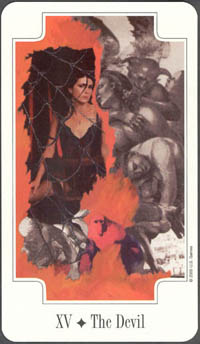 The cardboard box the deck comes in depicts The Magician, which is a good and obvious choice. That the
original back pattern, depicting a lizard, snake and spider in a cobweb, has been substituted by a dull
computer-made optical pattern is regrettable, as the spider and cobweb play an important
part in the deck, like in The Devil, where you also can find a portrait of the artist herself. Another
small improvement is the titles on each card substituting the suit symbols.
The cardboard box the deck comes in depicts The Magician, which is a good and obvious choice. That the
original back pattern, depicting a lizard, snake and spider in a cobweb, has been substituted by a dull
computer-made optical pattern is regrettable, as the spider and cobweb play an important
part in the deck, like in The Devil, where you also can find a portrait of the artist herself. Another
small improvement is the titles on each card substituting the suit symbols.
Conclusion: Despite its flaws, the US Games Systems' edition has added improvements to the deck. Arnell Ando's
outstanding collage work is well-preserved in general, the major and regrettable difference being the
change of the overall color of the deck. You can confidently buy the deck for its own qualities and also
for its value as a historical document, which began a new tarot trend.
|